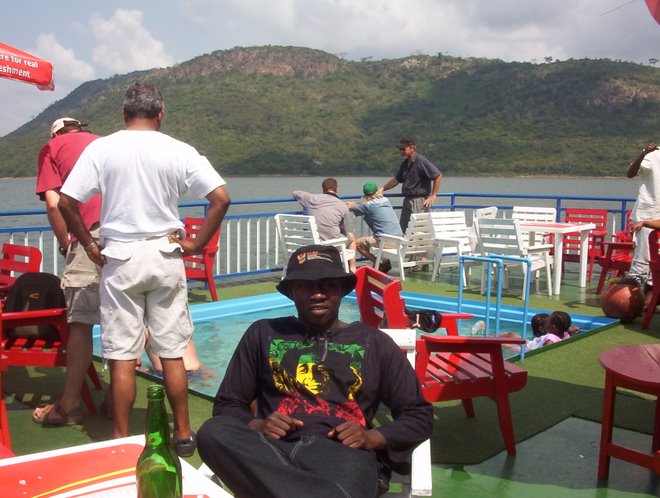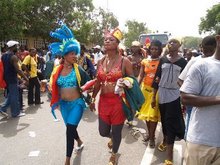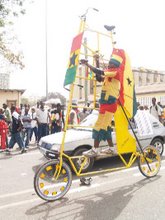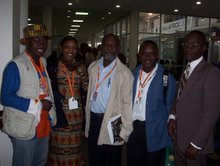
Last Sunday’s Akwasidae festival, celebrated at the forecourt of the Manhyia Palace, portrayed once again the rich culture of the Asanteman Kingdom and the international dimension the festival has assumed.
Otumfuo OseiTutu II who sat in state was adorned with gold ornament at almost all parts of the body, and crowned it with a beautiful native sandals to match.
He was at his usual best when it comes to traditional way of dressing, but it was President John Agyekum Kufour, who stole the show when he obliged the former Mayor of Kumasi, Okumkom Nana Akwasi Agyemang to a kete dance just before he left the durbar grounds.
It was Nana Akwasi, as he is popularly referred to in Kumasi, who initiated the move by teasing President Kufour to kete dance.
President Kufour was by then, bidding farewell to the numerous celebrants who had converged at the forecourt of the Manhyia Palace to take part in the Akwasidae celebration.
The May 6th, 2007, Akwasidae festival was unique, in that, it fell on the 57th birth day of Otumfuo Osei Tutu II, and also marked the 8th anniversary celebration of the enstoolment of the King on the Golden Stool.
It was therefore not surprising that Otumfuo Osei Tutu was adorned in gold ornaments to showcase the richness of the Asanteman kingdom in terms of gold to mark the great day.
As usual, President Kufour also appeared in kente cloth, with a beautiful native sandals to match and after participating in the event for over two hours where he presented Otumfuo Osei Tutu with assorted drinks, including schnapps, champagne and wine, he decided to bid farewell to the celebrants, and it was at that time that Nana Akwasi teased him to the kete dancing show.
For over five minutes, the two great sons of Asanteman treated the celebrants to unique kete dance. Their steps, hand signals, smiles which go with the dance and body signs proved the abundance of skills they had, and this brought many of the celebrants to their feet which added much flavour to the celebration.
Ten minutes after President Kufour left the scene, former President Jerry John Rawlings also appeared and took his seat.
His presence also added much colour to the already charged atmosphere, and a few minutes later, he also paid homage to Otumfuo by not only embracing the King, but also presented drinks to support the occasion.
Apart from dignitaries who attended the festival from neighbouring countries such as Cote d’ Ivoire, Nigeria and Burkina Faso among others, and paid homage to the Asantehene, a special delegation from Libya led by the Vice Chancellor of the Al Fateh University in Libya, Professor Salah M. Azwal, also participated in the celebration and presented some gifts to the Asantehene, Otumfuo Osei Tutu II.
Professor Azwal was led to the durbar grounds by the Vice Chancellor of the Kwame Nkrumah University of Science and Technology, Professor Kwasi Kwafo Adarkwa.
Some Chiefs, from Yamousukro who trace their lineage to Ghana , together with other Chiefs from various parts of the country, also joined Asanteman to celebrate the occasion .
Among the dignitaries who accompanied President Kufour were the Ashanti Regional Minister, Mr Emmanuel Asante Owusu Ansah, the Minister of Defence, Dr, Addo Kufour, the Minister of Finance, Mr Kwadwo Baah Wiredu, the Minister of Trade ,Industry and Presidential Special Initiatives, Mr Allan Kyeremanten and the Minister of Works and Housing, Mr Hackman Owusu Agyemang.
Others were, the Minister of Interior, Mr Albert Kan Dapaah, the Minister of Chieftaincy Affairs, Mr Sampson Kwaku Boafo, the Deputy Minister of the Ashanti Region, Mr Osei Asibey Antwi, the Mayor of Kumasi, Madam Patricia Appiagyei, Deputy Minister of Works and Housing and Madam Cecilia Abena Dapaah
The Chief Executive of the Korle Bu Teaching Hospital, Professor Kwabena Frimpong Boateng, The Chief Executive of Komfo Anokye Teaching Hospital, Dr Anthony Nsiah Asare, the Ashanti Regional Director of Health Services, Dr Kofi Asare , the Ashanti Regional Director of Education, Mrs Bellinder Serwaa Addo, also joined the Asanteman Kingdom to celebrate the unique Akwasidae festival.
Other dignitaries included the British High Commissioner to Ghana, HIs Excellency Gordon Wetherell and his American counterpart, as well as the Brazilian, Netherlands and Nigeria Ambassadors to Ghana.
As usual, the Paramount, Divisional and sub Chiefs of Asanteman were there in their numbers, and the various colours of their cloth, native sandals and umbrella brought home the rich cultural values of the kingdom.
Their dressing, especially the gold ornaments which adorned them, their turbans and the beads they wore among others, did not only add colour to the festival, but also proved the steadfastness that the present generation has held to the legacy that past generation has bestowed to us, as well as the manner the present generation is fusing the customs, traditional values and culture to the future generation.
By 10 am, all seats at the durbar grounds were filled up and the celebrants expectantly waited for Otumfuo Osei Tutu to arrive at the durbar grounds to take his seats to enable them pay homage and present their gifts as the occasion demanded.
President Kufour finally arrived at 11;50 am, and was treated to a rousing welcome as soon as he arrived in his rich kente cloth. He took time to go round to greet some of the dignitaries who had already taken their seat, and ten minute later, Otumfuo Osei Tutu , riding in a palanquin and bustling with life also arrived.
It was the Kete drummers who heralded the arrival of the Asantehene and his retinue onto the durbar grounds at 12 noon, and his arrival ignited life onto the grounds which was already busting.
In the palanquin, Otumfuo portrayed his skills in traditional dancing as he confidently responded to the kete drummers, which reached its climax when he reached the dais where President Kufour and other government officials were seated.
President Kufour responded by standing up and pointed his fore and middle fingers at the Asantehene to show his admiration for his dancing skills and his unflinching support for his reign.
The scene lasted for just over two minutes, but the message it portrayed was not only profound but memorable as well.
The presence of President John Agyekum Kufour and former President Jerry John Rawlings at different points of the day also became a topic of discussion among the celebrants.
While President Kufour, together with some Ministers of state and Parliamentarians arrived at the fore court of the Manhyia Palace where the festival was celebrated at 11; 50 am, former President Rawlings, together with Mr Daniel Ohene Agyekum, a former Ashanti Regional Minister, Mr Victor Smith, Special Aide to former President Rawlings, and Dr Stephen Opuni of the Komfo Anokye Teaching Hospital, arrived there a few minutes after President Kufour and some of his entourage had left the durbar grounds.
The presence of the two dignitaries at different points of the festival, was cheered by the chiefs and people of Asanteman who were participating in the Akwasidae festival.
The Bantamahene, Baffour Asare Owusu VI, the Paramount Chief of Tepa Traditional Area, Nana Adusei Atwerewa Ampem, the Chief of Apeadu, Odeefuo Owusu Amoaye, The Paramount Chief of Agogo Traditional Area, Nana Akuoko Sarpong, the Paramount Chief of Manso Nkwanta, Nana Bi- Kusi, the Paramount Chief of Asokore Traditional Area, Nana Susubribi Krobea Asante, as well as the Asokore Mamponghene, Nana Boakye Ansah Debrah,the Paramount Chief of Bechem traditional Area, Nana Ofosu Gyeabuo Akoto, were among the traditional rulers who joined the Asantehene to celebrate the festival.
The Editor of the Daily Graphic, Mr Yaw Boadu Ayeboafoh, the General Manager of the Ghana News Agency, Nana Appau Duah, as well as the Editorial Consultant of the News Times Corporation, Mr Ebo Quansah were also present.
Some Members of the Council of State including Professor John Nabila, were also present and fully participated in the festival.
Some Chiefs from Cote D Ivoire, and a delegation from the Benin State in Nigeria led by the Governor of the State ,also joined the Asantehene to celebrate the festival.
The clergy, which included the Arch Bishop of the Kumasi Catholic Diocese, Rt. Rev Peter Kwasi Sarpong, the Methodist Bishop of Kumasi, Nuben Abubakr, the Bishop of the Kumasi Anglican Diocese RT. Rev Oyinka Sarfo were not left out of the unique Akwasi festival celebration.
AS soon as the Asantehene arrived at the durbar grounds, he went round to greet the dignitaries, which included President Kufour and his entourage as well as the Paramount Chiefs of Asanteman, foreign dignitaries and a cross section of the public.
In the palanquin, Otumfuo Osei Tutu responded to the Fontomfrom and Kete drummers with a stylish dance which portrayed the rich culture and custom of Asanteman.
Just after he sat in state, President Kufour was led by the Ashanti Regional Minister, Mr E.A Owusu Ansah and the Mayor of Kumasi, Madam Patricia Appiagyei to pay homage to Otumfuo Osei Tutu and congratulated him on his 57th birthday celebration.
They also congratulated him on his eighth year reign as the occupant of the Golden Stool and wished him well on the Akwasidae festival celebration which attracted both local and foreign dignitaries.
It was at that point that the Ashanti Regional Minister presented the drinks.
The dignitaries who participated then took turns to pay homage to Otumfuo Osei Tutu and presented him with gifts and wished him well on his reign.
Just before President Kufour left the durbar grounds, he engaged the former Mayor of Kumasi, Nana Akwasi Agyeman to kete dancing, which attracted the dignitaries.
It was a few minutes after President Kufour left the place that former President Rawlings also arrived to greet the Asantehene, Otumfuo Osei Tutu II, and the dignitaries and later presented his gift to the Asantehene and wished him well on the celebration and God’s guidance on his reign as the Asantehene.
THE biggest single demolition exercise ever to hit the ‘Garden City’ of Kumasi took place yesterday when the Kumasi Metropolitan Assembly (KMA) razed down Sodom and Gomorrah, a sprawling slum near Adum, sending more than 3000 residents looking for places to lay their heads.
Some wailed uncontrollably and two nursing mothers holding strongly to their one-week and three-day old babies were seen running away to a safer place.
To a question as to whether the KMA would look for an alternative place for the residents to live, the engineer said “we are not duty-bound to look for a place for them”







































